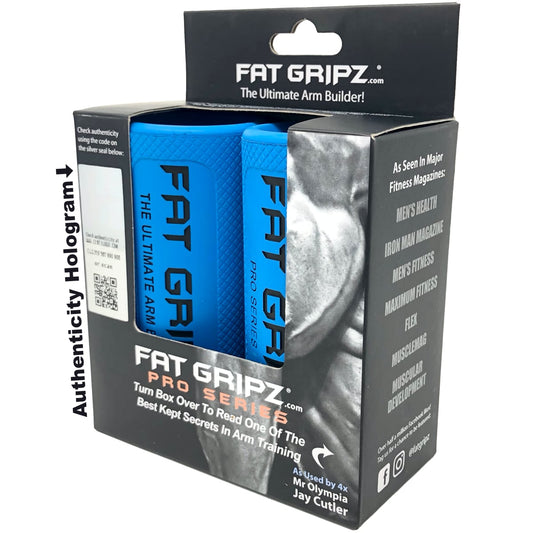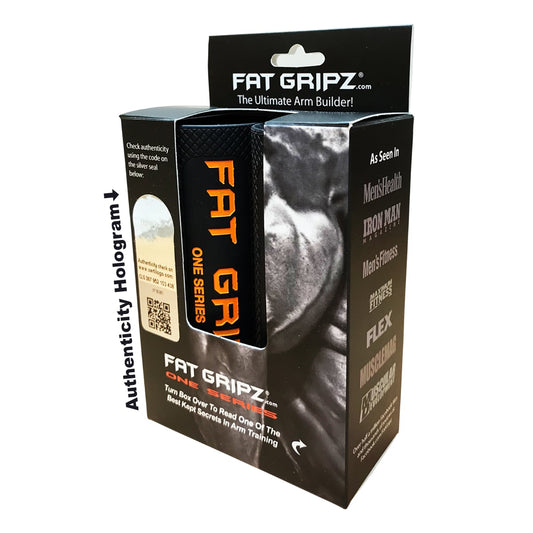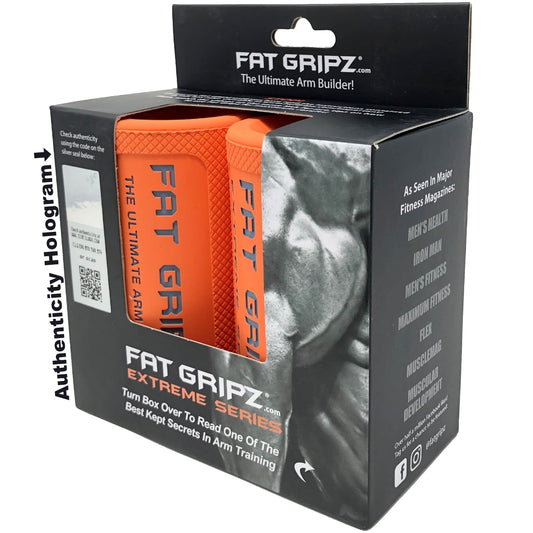Thick Bar Training The Science Behind Fat Gripz
Fat Gripz / thick bars develop levels of muscle and strength that cannot be duplicated with standard equipment. It is not uncommon for even an experienced lifter to make significant muscle gains in just a few months by switching to thick bars
Thick Bar Training
Thick bar training has been around for decades. Old-time strongmen used it to develop levels of size and strength that are virtually incomprehensible today.
Thick bars are simply barbells, dumbbells and pull-up bars with a thicker handle. Standard equipment usually has a 1 inch thick handle. Thick/fat bars usually have 1.75 to 2.75 inch thick handles.
Thick bar training originated because in the old days there was no real strength equipment available so lifters improvised with railway and truck axels as barbells.
Thick bar training simply means using a thick barbell, thick dumbbells and thick chin-up bar in your usual training program.
Today thick bar training is used almost exclusively by elite soldiers, pro athletes and champion bodybuilders because they know the secrets of how to train most effectiely and have the money to afford very expensive thick bars, thick-handled dumbbells and thick pull-up bars. A full set of all of these can cost many tens of thousands of dollars.
It’s quite amazing to see how something as simple as switching to a thick bars can supposedly unlock such major muscle and strength gains, not just in the hands and forearms, but throughout the whole body. That understandable skepticism might change the first time you use a thick bar. In fact, you may want to take it easy the first time. Many trainees report that their forearms and biceps are sore to the touch for days after the first time using with a thick bar.
There are several reasons why they work so well:
Irradiation and Harder Muscle Contractions
Thicker handles stimulate far more muscle activation in the hands and forearms and in the upper arms and whole upper body. It works by the principle of irradiation. When you contract a muscle hard, the muscles around it contract as well. Therefore, to get a maximal contraction in your biceps, for example, you need to get your forearms contracting maximally too. Of course, more muscle activation means significantly bigger muscle and strength gains.
Weak Links (and "Neural Inhibition") Eliminated
Your body is highly sophisticated. It has protective mechanisms built-in to minimize the risk of imbalance and injury. Therefore, it will “hold back” the strength and size of some muscles if it detects that other muscles around it are too weak. This is known as “neural inhibition”.
This is one reason that successful powerlifters work hard to build huge, powerful back muscles…. to improve their bench press. Sounds counter-intuitive at first but training your back “pulling” muscles gets you stronger on your front “pushing” muscles. They do this because they know that their body needs that balance and stability to get stronger.
Your hands are the point of contact with the weight in almost every exercise but most lifters greatly underestimate the role the hands play in getting stronger and bigger. Thick bars make your hands, fingers and forearms so much stronger that your body can finally stop “holding back” the muscle and strength gains in your upper arms, back and chest.
Training at All Angles, Automatically
Thick bar training automatically trains your hands, fingers and forearms at all angles. If you are bench pressing, the thick bar will train your hands and forearms in a completely different way than if you are doing chin ups on a thick bar. Other grip training methods like grippers can be useful too but they are one-dimensional, training the hands and forearms in the same way over and over which can potentially lead to imbalances and injury. Thick bars also perfectly replicate the natural function of the human hand – lifting heavy, awkward objects. Humans have evolved to use their hands to climb trees and rock faces, carry logs and animals. Thick bars are a great way of replicating this.
Your Body is Only as Strong as it's Weakest Link
If your back and legs can deadlift 700lbs but your arms can only hold 300lbs, your deadlift is 300lbs. By strengthening your hands, wrists, forearms and upper arms with thick bars you can make the whole body stronger
Less Stress on Joints, Less Injuries, Less Imbalances
Many people use thick bar training because of how fast it adds muscle to their body compared to standard bar but many lifters report that thick bar training has actually helped (and presumably therefore, reduced the chance of) all types of injuries including wrist, elbow and shoulders issues. It seems that thick bars shift the stress off the joints and onto the muscles which is, of course, exactly what we want. This effect is thought to be because a thick bar spreads the weight over a larger area of the hand (just imagine bench pressing with a thick bar) which, in turn, means that that weight is more evenly distributed throughout the entire arm. It’s a bit like this difference between someone standing on you wearing sneakers and someone standing on you wearing high-heeled shoes. In addition, the thick bar also changes the biomechanics of the lift enough so that when you pick up a thick bar, forearms extensors (the muscles on the top of the forearm) and forearm flexors (the muscles on the bottom) both work similar amounts (if you just pick up a thick-handled dumbbell you will instantly feel that). With standard bars, the forearm flexors do almost all the work which can cause imbalances, injuries, strength plateaus and tendonitis. Of course, fewer injuries mean more productive training too because consistency is essential.
To incorporate thick bar training into your training simply use them for everything. Use thick barbells, dumbbells and pull-up bars for all exercises – bench presses, overhead presses, chin-ups, pull-ups, rows, deadlifts, curls and tricep extensions.
A NOTE OF CAUTION: Take extra care when you begin to incorporate thick bar work. Drop the poundage at first. You may not be able to handle your regular poundage when you first begin thick bar movements but, don’t worry, your hands and forearms will quickly catch up and you will blow your old max lifts out of the water.
Here at FatGripz.com, we created Fat Gripz when we learned how many pro athletes and bodybuilders had used thick bars to develop massive arm size and strength and then found how well they worked when we tested them ourselves. Unfortunately, thick bars and thick-handled dumbbells are very rare and very expensive so we created Fat Gripz to make the benefits of thick bar training available and affordable to everyone. We are very proud that today Fat Gripz are highly thought of in the strength community and are used extensively by many: military (they are used by the U.S. Special Forces Expeditionary Warfare Group and the British Royal Marine Commandos), champion bodybuilders (including 2 Mr Olympias – Jay Cutler and Phil Heath), NFL teams, NBA players and athletes across many physique and strength sports.
Conclusion: Fat Gripz / thick bars develop levels of muscle and strength that cannot be duplicated with standard equipment. It is not uncommon for even an experienced lifter to make significant muscle gains in just a few months by switching to thick bars. Get some Fat Gripz and unlock some major muscle and strength gains!
Fat Gripz Products
Whether You are a Beginner, Intermediate or Advanced, Fat Gripz will Help You Get Big Biceps and Forearms Fast
-
Fat Gripz Pro

 OUTER DIAMETER:2.25 inches / 5.7 centimeters
OUTER DIAMETER:2.25 inches / 5.7 centimetersNot in USA? Select Country Below
United States -
Fat Gripz One

 OUTER DIAMETER:1.75 inches / 4.5 centimeters
OUTER DIAMETER:1.75 inches / 4.5 centimetersNot in USA? Select Country Below
United States -
Fat Gripz Extreme
 OUTER DIAMETER:2.75 inches / 7 centimeters
OUTER DIAMETER:2.75 inches / 7 centimetersNot in USA? Select Country Below
United States -
Total Progression Bundle
 OUTER DIAMETER:All 3 sizes
OUTER DIAMETER:All 3 sizes
Not in USA? Select Country Below
United States
Proven to Get Big Biceps & Forearms Fast
See some real world results
- Choosing a selection results in a full page refresh.





